tow FIAT STRADA 2011 Owner handbook (in English)
[x] Cancel search | Manufacturer: FIAT, Model Year: 2011, Model line: STRADA, Model: FIAT STRADA 2011Pages: 195, PDF Size: 3.68 MB
Page 110 of 195
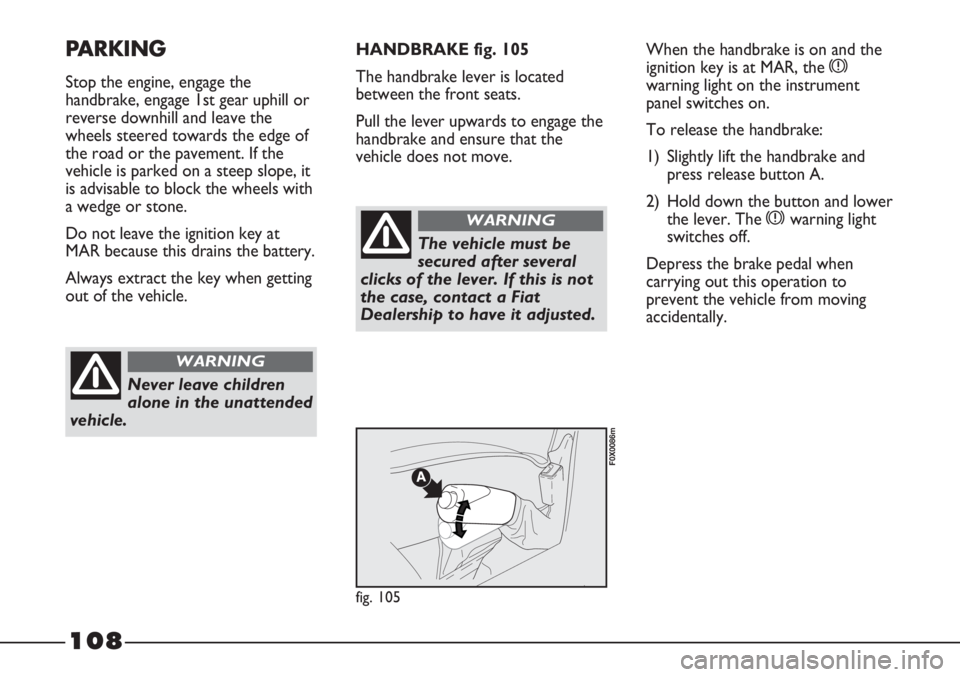
108
PARKING
Stop the engine, engage the
handbrake, engage 1st gear uphill or
reverse downhill and leave the
wheels steered towards the edge of
the road or the pavement. If the
vehicle is parked on a steep slope, it
is advisable to block the wheels with
a wedge or stone.
Do not leave the ignition key at
MAR because this drains the battery.
Always extract the key when getting
out of the vehicle.
Never leave children
alone in the unattended
vehicle.
WARNING
HANDBRAKE fig. 105
The handbrake lever is located
between the front seats.
Pull the lever upwards to engage the
handbrake and ensure that the
vehicle does not move.When the handbrake is on and the
ignition key is at MAR, the x
warning light on the instrument
panel switches on.
To release the handbrake:
1) Slightly lift the handbrake and
press release button A.
2) Hold down the button and lower
the lever. The xwarning light
switches off.
Depress the brake pedal when
carrying out this operation to
prevent the vehicle from moving
accidentally.
The vehicle must be
secured after several
clicks of the lever. If this is not
the case, contact a Fiat
Dealership to have it adjusted.
WARNING
fig. 105
F0X0086m
Page 112 of 195

110
To engage reverse (R), wait for the
vehicle to stop and, from neutral,
move the lever to the right and then
backwards, lifting ring A of the
reverse inhibitor device.
Fully depress the clutch
pedal to change gears
correctly. Therefore, the floor
area underneath the clutch
pedal must not be obstructed
in any way. Ensure that the
floor mat is always laid flat
and does not interfere with use
of the pedals.
WARNING
Do not drive with your
hand resting on the gear
lever as the force
exerted, even if slight, could
lead over time to premature
wear of the internal gearbox
components.
The clutch pedal must be used
only for gear changes. Do not
drive with your foot resting on
the clutch pedal, however
lightly.
For versions/markets where
provided, the electronic clutch
control could intervene,
interpreting the incorrect driving
style as a fault.LOADING ADVICE
The vehicle has been designed and
type approved on the basis of
certain maximum weights (see
“Weights” table in the “Technical
Specifications” section):
– kerb weight
– payload
– maximum weight on front axle
– maximum weight on rear axle
– towable weight.
Each of these limits
must be kept firmly in
mind and, in any event, never
exceeded.
WARNING
Page 114 of 195
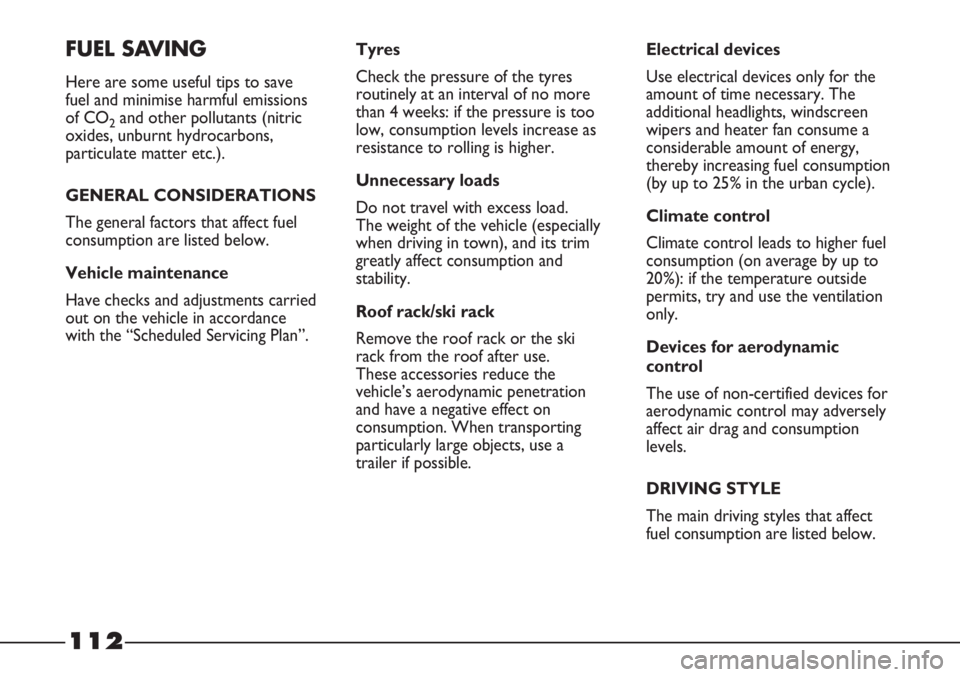
112
FUEL SAVING
Here are some useful tips to save
fuel and minimise harmful emissions
of CO
2and other pollutants (nitric
oxides, unburnt hydrocarbons,
particulate matter etc.).
GENERAL CONSIDERATIONS
The general factors that affect fuel
consumption are listed below.
Vehicle maintenance
Have checks and adjustments carried
out on the vehicle in accordance
with the “Scheduled Servicing Plan”.Tyres
Check the pressure of the tyres
routinely at an interval of no more
than 4 weeks: if the pressure is too
low, consumption levels increase as
resistance to rolling is higher.
Unnecessary loads
Do not travel with excess load.
The weight of the vehicle (especially
when driving in town), and its trim
greatly affect consumption and
stability.
Roof rack/ski rack
Remove the roof rack or the ski
rack from the roof after use.
These accessories reduce the
vehicle’s aerodynamic penetration
and have a negative effect on
consumption. When transporting
particularly large objects, use a
trailer if possible.Electrical devices
Use electrical devices only for the
amount of time necessary. The
additional headlights, windscreen
wipers and heater fan consume a
considerable amount of energy,
thereby increasing fuel consumption
(by up to 25% in the urban cycle).
Climate control
Climate control leads to higher fuel
consumption (on average by up to
20%): if the temperature outside
permits, try and use the ventilation
only.
Devices for aerodynamic
control
The use of non-certified devices for
aerodynamic control may adversely
affect air drag and consumption
levels.
DRIVING STYLE
The main driving styles that affect
fuel consumption are listed below.
Page 116 of 195
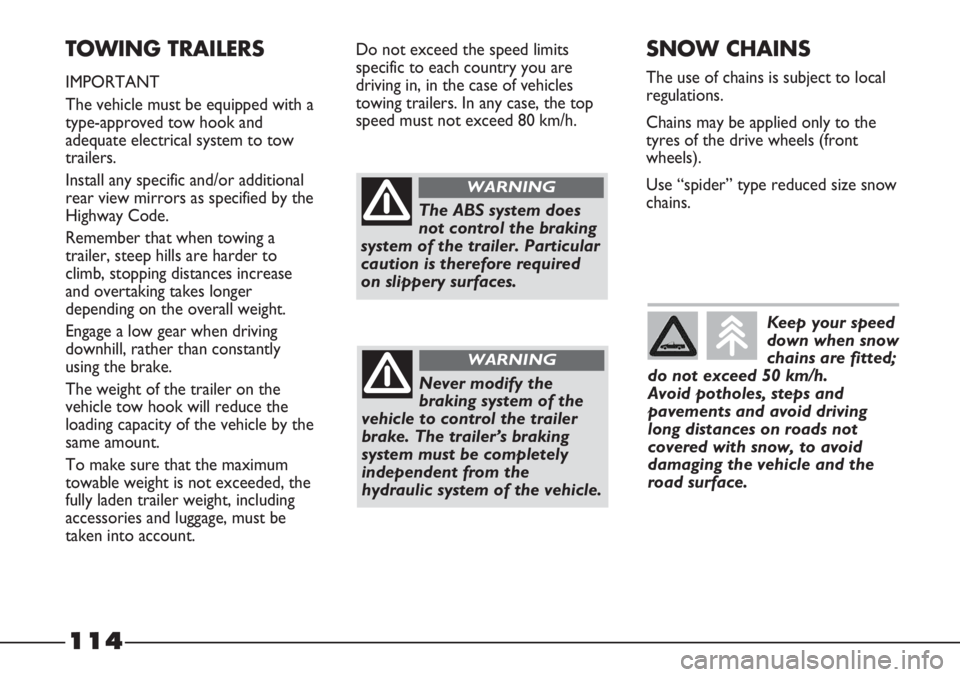
114
TOWING TRAILERS
IMPORTANT
The vehicle must be equipped with a
type-approved tow hook and
adequate electrical system to tow
trailers.
Install any specific and/or additional
rear view mirrors as specified by the
Highway Code.
Remember that when towing a
trailer, steep hills are harder to
climb, stopping distances increase
and overtaking takes longer
depending on the overall weight.
Engage a low gear when driving
downhill, rather than constantly
using the brake.
The weight of the trailer on the
vehicle tow hook will reduce the
loading capacity of the vehicle by the
same amount.
To make sure that the maximum
towable weight is not exceeded, the
fully laden trailer weight, including
accessories and luggage, must be
taken into account.Do not exceed the speed limits
specific to each country you are
driving in, in the case of vehicles
towing trailers. In any case, the top
speed must not exceed 80 km/h.
The ABS system does
not control the braking
system of the trailer. Particular
caution is therefore required
on slippery surfaces.
WARNING
Never modify the
braking system of the
vehicle to control the trailer
brake. The trailer’s braking
system must be completely
independent from the
hydraulic system of the vehicle.
WARNING
SNOW CHAINS
The use of chains is subject to local
regulations.
Chains may be applied only to the
tyres of the drive wheels (front
wheels).
Use “spider” type reduced size snow
chains.
Keep your speed
down when snow
chains are fitted;
do not exceed 50 km/h.
Avoid potholes, steps and
pavements and avoid driving
long distances on roads not
covered with snow, to avoid
damaging the vehicle and the
road surface.
Page 120 of 195

118
BUMP STARTING
Never bump start the engine by
pushing, towing or driving downhill.
This could cause fuel to flow into
the catalytic converter and damage it
beyond repair.
IMPORTANT The brake servo and
power steering are not operational
until the engine has been started, so
you need to apply much more force
than usual to the brake pedal and
steering wheel.IF A TYRE IS
PUNCTURED
General instructions
To use the jack and
space-saver wheel
correctly, some
precautions are necessary,
described below.
Never use a quick
battery charger to start
the engine as this could
damage the electronic systems,
particularly the ignition and fuel
supply control units.
Incorrect positioning of
the jack may cause the
raised vehicle to fall. Do not
use the jack for loads greater
than that indicated on the jack
itself. The jack is only to be
used for replacing wheels on
the vehicle with which it is
provided. Never use the jack
for other purposes, such as
lifting other vehicles. Never use
the jack to carry out repairs
under the vehicle. Do not
grease the threads of bolts
before fitting them: they might
slip out.
WARNING
This procedure must be
performed by expert
personnel as incorrect actions
may cause high-intensity
electrical discharge.
Furthermore, battery fluid is
poisonous and corrosive: avoid
contact with skin and eyes.
Keep naked flames and lit
cigarettes away from the
battery. Do not create sparks.
WARNING
Page 142 of 195

140
Before towing, turn the
ignition key to MAR
and then to STOP without
extracting it. If the key is
removed, the steering lock will
activate automatically and it
will be impossible to steer the
wheels.
WARNING
The tow hook must be
used exclusively for
roadside assistance operations.
You are allowed to tow the
vehicle for short distances using
an appropriate device in
accordance with the highway
code (rigid bar), to move the
vehicle on the road in readiness
for towing or transport via a
breakdown vehicle. The tow
hook MUST NOT be used to
tow vehicles off the road or
where there are obstacles
and/or for towing operations
using cables or other non-rigid
devices. In compliance with the
above conditions, towing must
take place with the two
vehicles (one towing, the other
towed) aligned as much as
possible along the same centre
line.
WARNING
fig. 149
F0X0132m
IF THE VEHICLE
MUST BE TOWED
The vehicle can only be towed at the
front.
The tow hook is supplied with the
vehicle.
It is located in the tool bag.
How to attach the tow hook:
1) Take the tow hook.
2) Remove the cover on the front
bumper fig. 149, prising it up using
a screwdriver in the notch on the
cover.
3) Fully tighten the ring on the
threaded pin.
Page 143 of 195
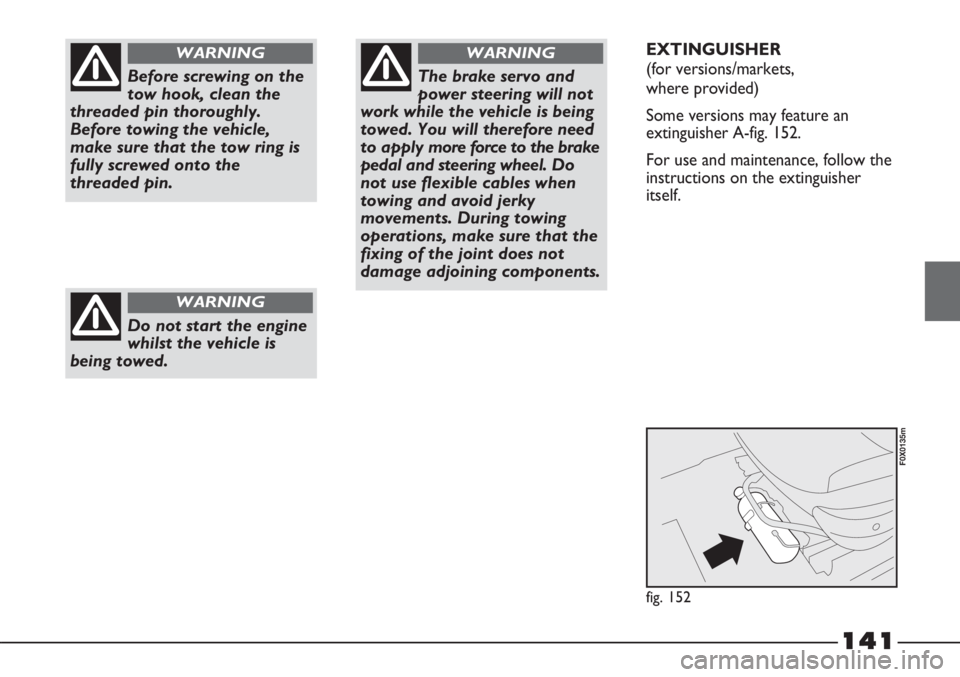
141
Before screwing on the
tow hook, clean the
threaded pin thoroughly.
Before towing the vehicle,
make sure that the tow ring is
fully screwed onto the
threaded pin.
WARNING
Do not start the engine
whilst the vehicle is
being towed.
WARNING
The brake servo and
power steering will not
work while the vehicle is being
towed. You will therefore need
to apply more force to the brake
pedal and steering wheel. Do
not use flexible cables when
towing and avoid jerky
movements. During towing
operations, make sure that the
fixing of the joint does not
damage adjoining components.
WARNINGEXTINGUISHER
(for versions/markets,
where provided)
Some versions may feature an
extinguisher A-fig. 152.
For use and maintenance, follow the
instructions on the extinguisher
itself.
fig. 152
F0X0135m
Page 145 of 195
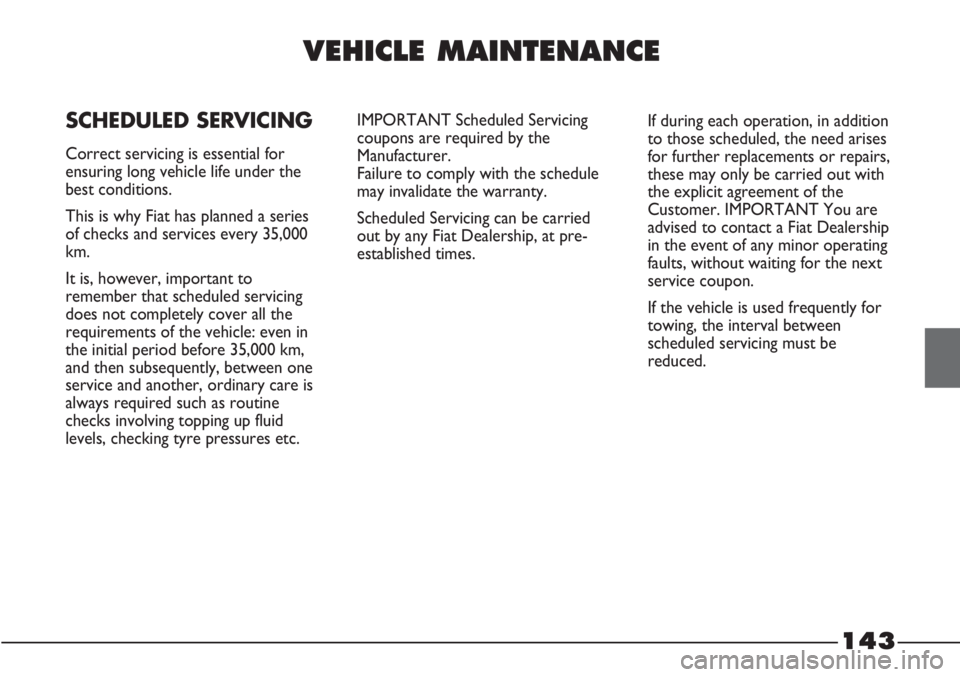
143
VEHICLE MAINTENANCE
SCHEDULED SERVICING
Correct servicing is essential for
ensuring long vehicle life under the
best conditions.
This is why Fiat has planned a series
of checks and services every 35,000
km.
It is, however, important to
remember that scheduled servicing
does not completely cover all the
requirements of the vehicle: even in
the initial period before 35,000 km,
and then subsequently, between one
service and another, ordinary care is
always required such as routine
checks involving topping up fluid
levels, checking tyre pressures etc.IMPORTANT Scheduled Servicing
coupons are required by the
Manufacturer.
Failure to comply with the schedule
may invalidate the warranty.
Scheduled Servicing can be carried
out by any Fiat Dealership, at pre-
established times.If during each operation, in addition
to those scheduled, the need arises
for further replacements or repairs,
these may only be carried out with
the explicit agreement of the
Customer. IMPORTANT You are
advised to contact a Fiat Dealership
in the event of any minor operating
faults, without waiting for the next
service coupon.
If the vehicle is used frequently for
towing, the interval between
scheduled servicing must be
reduced.
Page 148 of 195
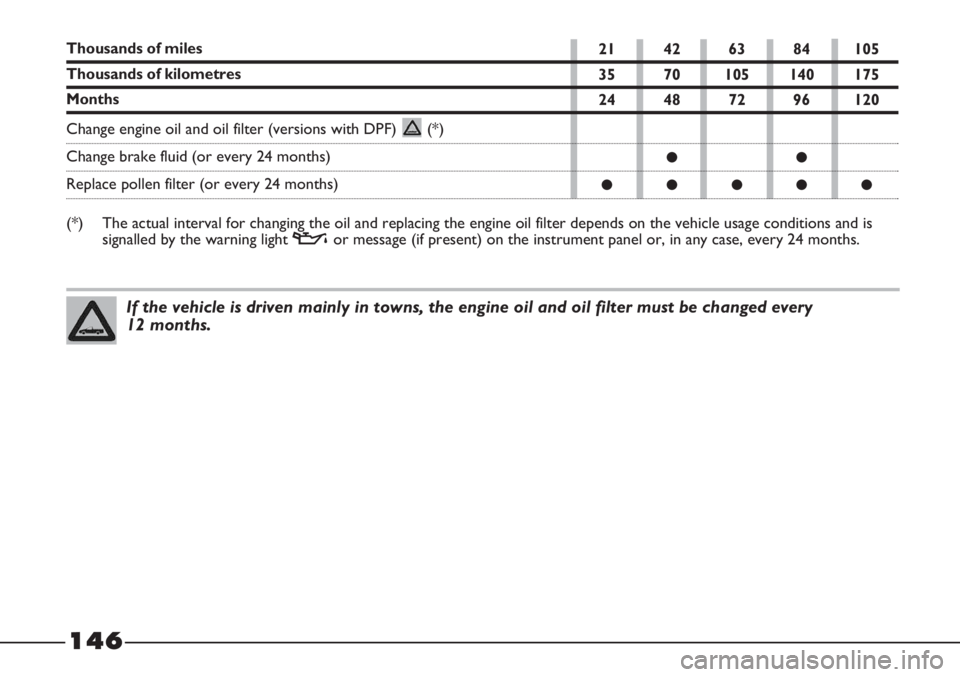
146
If the vehicle is driven mainly in towns, the engine oil and oil filter must be changed every
12 months.
21 42 63 84 105
35 70 105 140 175
24 48 72 96 120
●●
●●●●●
Thousands of miles
Thousands of kilometres
Months
Change engine oil and oil filter (versions with DPF) (*)
Change brake fluid (or every 24 months)
Replace pollen filter (or every 24 months)
(*) The actual interval for changing the oil and replacing the engine oil filter depends on the vehicle usage conditions and is
signalled by the warning light vor message (if present) on the instrument panel or, in any case, every 24 months.
Page 149 of 195
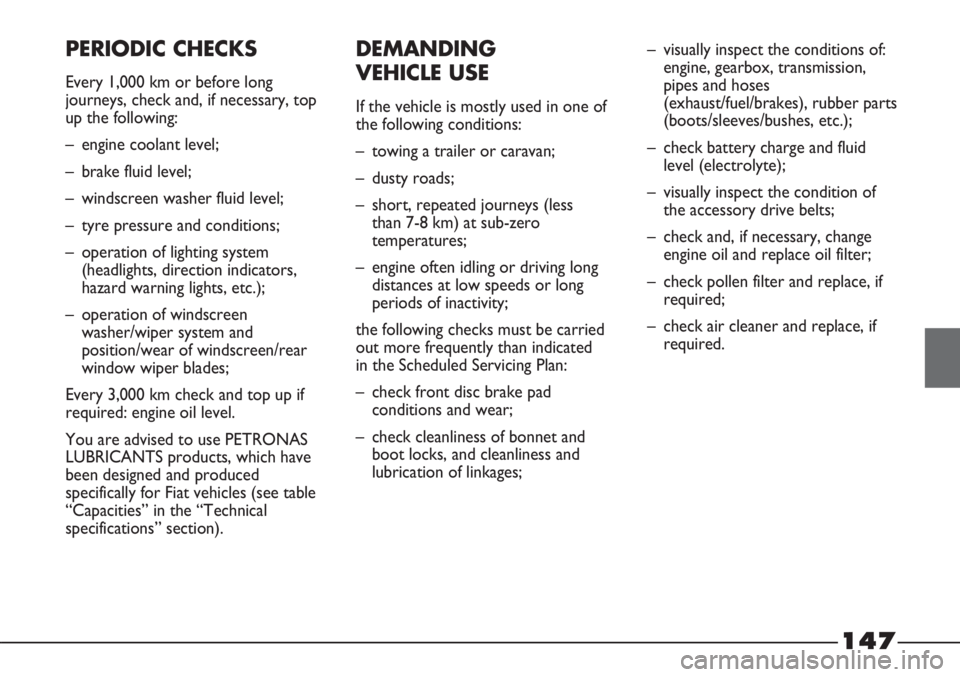
147
PERIODIC CHECKS
Every 1,000 km or before long
journeys, check and, if necessary, top
up the following:
– engine coolant level;
– brake fluid level;
– windscreen washer fluid level;
– tyre pressure and conditions;
– operation of lighting system
(headlights, direction indicators,
hazard warning lights, etc.);
– operation of windscreen
washer/wiper system and
position/wear of windscreen/rear
window wiper blades;
Every 3,000 km check and top up if
required: engine oil level.
You are advised to use PETRONAS
LUBRICANTS products, which have
been designed and produced
specifically for Fiat vehicles (see table
“Capacities” in the “Technical
specifications” section).
DEMANDING
VEHICLE USE
If the vehicle is mostly used in one of
the following conditions:
– towing a trailer or caravan;
– dusty roads;
– short, repeated journeys (less
than 7-8 km) at sub-zero
temperatures;
– engine often idling or driving long
distances at low speeds or long
periods of inactivity;
the following checks must be carried
out more frequently than indicated
in the Scheduled Servicing Plan:
– check front disc brake pad
conditions and wear;
– check cleanliness of bonnet and
boot locks, and cleanliness and
lubrication of linkages;– visually inspect the conditions of:
engine, gearbox, transmission,
pipes and hoses
(exhaust/fuel/brakes), rubber parts
(boots/sleeves/bushes, etc.);
– check battery charge and fluid
level (electrolyte);
– visually inspect the condition of
the accessory drive belts;
– check and, if necessary, change
engine oil and replace oil filter;
– check pollen filter and replace, if
required;
– check air cleaner and replace, if
required.